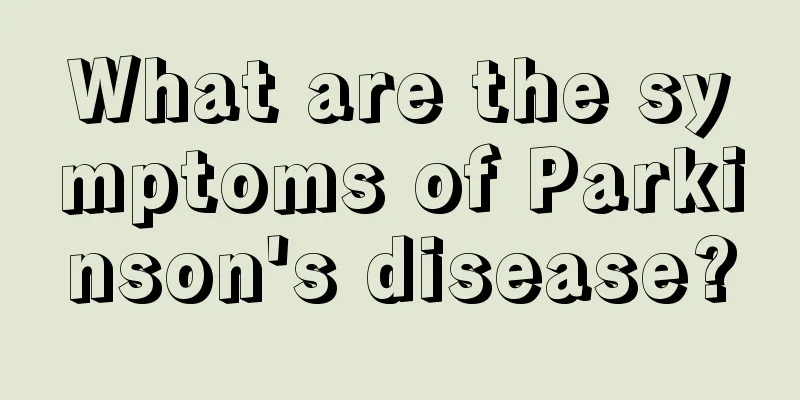What are the symptoms of Parkinson's disease?

|
We all know that there are many diseases that affect our aging parents' generation, such as Alzheimer's disease, commonly known as senile dementia. This disease will cause our parents to forget a lot and eventually become like a child. There are also diseases like Parkinson's disease, which makes our parents gradually have difficulty in moving and even their bodies become twisted. So what are the specific symptoms of Parkinson's patients? Parkinson's symptoms: 1. General Information: It is more common in middle-aged and elderly people, with an insidious onset. Patients over 50 years old account for more than 90% of the total number of patients. It has a chronic progressive course, and about half of the patients need help after 5 to 8 years. Tremor, rigidity, akinesia (or decreased movement) and posture and balance disorders are the main manifestations. 2. First symptoms There are individual differences, and those with hyperactivity as the main symptom are easier to diagnose early. The first symptoms were tremor (70.5%), rigidity or slow movements (19.7%), loss of dexterity and/or writing difficulties (12.6%), gait disorders (11.5%), myalgia, spasm and pain (8.2%), mental disorders such as depression and tension (4.4%), language disorders (3.8%), general fatigue and muscle weakness (2.7%), drooling and mask-like face (1.6% each). It is generally believed that the average time from onset to diagnosis is 2.5 years. (1) Tremor: Tremor is caused by the rhythmic (4-6Hz) alternating contraction of the agonist and antagonist muscles of the limbs. It usually starts from the distal end of one upper limb and gradually spreads to the ipsilateral lower limb and the contralateral upper and lower limbs. The jaw, lips, tongue, and head are usually affected last. Tremors in the upper limbs are often more severe than in the lower limbs. Rhythmic tremors in the fingers form the so-called "pill-rolling movement". In the early stages of the disease, tremors only occur when the limbs are at rest. They can be alleviated or temporarily stopped during voluntary movements, aggravated by emotional excitement, and completely stop during sleep. Strong will and subjective efforts can temporarily suppress tremors, but they tend to worsen afterwards. (2) Rigidity: The muscle tone of both agonist and antagonist muscles increases. When the joint is subjected to passive movement, the increased muscle tension remains consistent and a uniform resistance is felt, which is called "lead pipe stiffness". If the patient also has tremor, he will feel intermittent pauses in uniform resistance when extending and flexing his limbs, like a gear turning, which is called "gear rigidity." Myotonia is more obvious when moving the neck muscles, elbows, wrists, shoulders, knees and ankles. Pay attention to letting the patient relax and overcome his unconscious "assistance". Due to muscle rigidity, the patient adopts a special posture. The head is tilted forward, the torso is flexed, the upper arms are adducted, the elbows are flexed, the wrists are extended, the fingers are adducted, the thumbs are facing each other, the interphalangeal joints are extended, and the hips and knees are slightly bent. As the disease progresses, these postural disturbances become progressively more severe. In severe cases, the waist can bend forward to almost a right angle; when the head tilts forward severely, the lower jaw can almost touch the chest. Severe muscle stiffness can cause limb pain. (3) Movement disorders (anokinesia or decreased movement): It is the main cause of disability due to Parkinson's disease. In the past, it was believed that akinesia was caused by muscle rigidity. Since surgical treatment of Parkinson's disease, it has been found that surgery can reduce or even eliminate muscle rigidity, but has little effect on reduced or less movement. Clinically, the degree of manifestation between muscle rigidity and hypokinesia is not parallel. It is currently believed that reduced exercise is related to DA deficiency. Movement disorders can manifest as: ① Difficulty in starting movement and slowing down of speed: He is unable to take care of himself in daily life, cannot stand up after sitting down, cannot turn over in bed, and has difficulty untying shoelaces and buttons, putting on and taking off shoes, socks or pants, shaving, washing face and brushing teeth. Repetitive movements can cause fatigue. ②Diversity movement defects: The characteristic facial features include lack of expression, few blinks and a "mask face". In severe cases, articulation, chewing and swallowing are difficult. Excessive drooling is caused by muscle movement disorders in the mouth, tongue, palate and pharynx, but there is no increase in saliva secretion, which is only caused by the patient's inability to swallow the saliva naturally. Severe patients may experience difficulty swallowing, and the accompanying movements of the upper limbs during walking may decrease or disappear. ③ Difficulty in movement transition: difficulty in switching from one movement state to another, resulting in movement cessation or repetition. For example, patients have difficulty with fine motor movements such as being unable to salute while walking, buttoning their clothes when answering questions, tying their shoelaces, etc. Continuous alternating movements often have pauses. Patients cannot make fine movements of their upper limbs and have difficulty writing. The handwritten words are crooked and become smaller and smaller as they write. This is called "micrographia". (4) Posture maintenance and balance disorders: When Parkinson's disease was first reported, it was proposed that abnormal posture and gait were the main manifestations of the disease. Martin (1967) believed that abnormalities in posture and gait were due to reflexive postural regulation disorders accompanied by active movements, which could occur in the early stages of Parkinson's disease. Difficulty starting, slow walking, forward gait, small stride length. When walking, it is difficult to start, but once you take a step, you rush forward with very small steps, getting faster and faster, and cannot stop or turn immediately. This is called panic gait. Turning is difficult due to trunk stiffness and balance disorder. Therefore, when the patient attempts to turn, he takes continuous small steps to turn the trunk and head together. Due to postural reflex adjustment disorders, the patient often walks unsteadily and falls, especially when turning and going up and down stairs. When standing, the patient is obviously unstable when pushed (pulled) lightly. Due to balance and posture disorders, patients bend their heads forward, their trunks bend forward, their knees and elbows bend, their hands are placed in front of their trunks, and their fingers are bent, forming a posture unique to this disease. |
<<: What to do if your scalp is very oily
>>: Pharyngitis causes severe cough, this is how you should stop the cough
Recommend
Can lung cancer be cured in its early stages? How long can one live?
Can lung cancer be cured in its early stages? How...
What does CK14 negative mean for breast cancer
Breast cancer CK14 is negative, which means that ...
Will endometrial cancer recur after treatment? If these symptoms occur, the possibility of recurrence is very high
For endometrial cancer, a common disease, the tre...
Nursing after anal diversion for rectal cancer
The occurrence of rectal cancer is mainly related...
Teach you how to make dimples yourself
Many people envy others for having a pair of swee...
What is the cause of lymphoma? What should we eat more to fight cancer?
What is the cause of lymphoma? What should we eat...
Can hamartoma be cured by taking medicine?
Hamartoma is a tumor disease that seriously endan...
What are the effects of bee flower sandalwood soap
Bee Flower Sandalwood Soap is a relatively common...
The source of measles infection is
Children have lower immunity than normal people. ...
Can early rectal cancer be cured?
Rectal cancer is no longer unfamiliar to many peo...
Why do people get thyroid disease?
Thyroid diseases are more serious in the summer a...
Is potassium hydroxide harmful to the skin?
The main use of potassium hydroxide is relatively...
How effective is the tooth plaque cleaner
We often see all kinds of micro-businesses in our...
What are the causes that are more likely to induce rectal cancer?
Rectal cancer is a relatively common cancer. Bad ...
How to make vegetarian cucumber steak
Cucumber is a very nutritious and delicious green...









